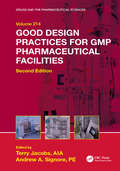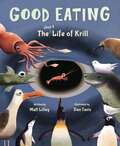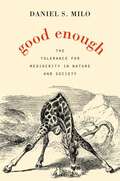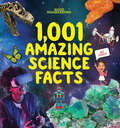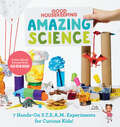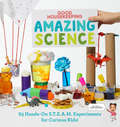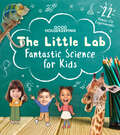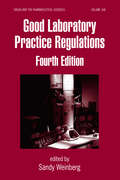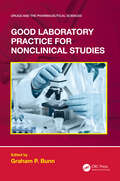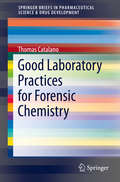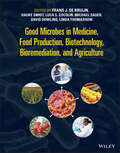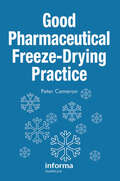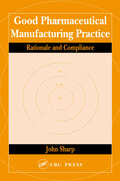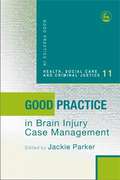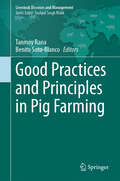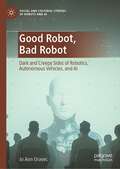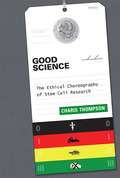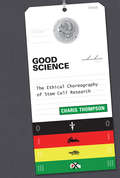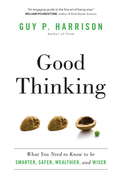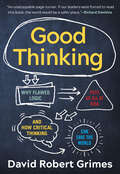- Table View
- List View
Good Design Practices for GMP Pharmaceutical Facilities (Drugs and the Pharmaceutical Sciences)
by Terry Jacobs Andrew A. SignoreThis revised publication serves as a handy and current reference for professionals engaged in planning, designing, building, validating and maintaining modern cGMP pharmaceutical manufacturing facilities in the U.S. and internationally. The new edition expands on facility planning, with a focus on the ever-growing need to modify existing legacy facilities, and on current trends in pharmaceutical manufacturing which include strategies for sustainability and LEED building ratings. All chapters have been re-examined with a fresh outlook on current good design practices.
Good Eating: The Short Life Of Krill
by Matt LilleyCalifornia Eureka Silver Honoree award 2022 "To my delight, your average krill is a far stranger story of metamorphosis than anything our butterflies can come up with." - Elizabeth Bird, A Fuse 8 Production A fun exploration of a tiny animal at the base of the ocean food chain Just 2 inches long full-grown, this little guy is the foundation of the Southern Ocean food chain... “Hi. What are you? You appear to be an egg. You are an egg sinking. For many days, you sink. You sink a mile down, and you keep sinking down… down… until…” The unidentified narrator follows one krill among billions as it pursues its brief existence, eating and eating while metamorphosing from one thing into another and trying to avoid being eaten. Questions and advice are hurled at the krill on every page, but the krill never responds—because, after all, krill can’t talk, and this is nonfiction. Krill are the largest animals able to catch and eat phytoplankton, and they in turn are eaten by the largest animals ever to live on earth—blue whales—as well as by seals, penguins, and a host of others. In other words, krill are really good at eating, and they make really good eating. And that makes them the most important animals in the high-latitude oceans. As in The Whale Fall Café, Dan Tavis’s illustrations combine scientific accuracy with Nemo liveliness and humor. Our star krill is so good at gobbling up phytoplankton that he turns green, so we can pick him out from the crowd racing to escape a penguin’s beak or a blue whale’s gaping maw. The book has been reviewed and endorsed by global krill expert Dr. Stephen Nichol, and the manuscript earned an honorable mention in Minnesota’s McKnight Artist Fellowships for Writers. Helpful backmatter is included. The Good Eating manuscript won an honorable mention in Minnesota’s McKnight Artist Fellowships for Writers. Technical review and endorsement from Dr. Stephen Nichol, adjunct professor at the University of Tasmania and author of The Curious Life of Krill.
Good Enough: The Tolerance for Mediocrity in Nature and Society
by Daniel S. MiloPhilosopher Daniel Milo offers a vigorous critique of the quasi-monopoly that Darwin’s natural selection has on our idea of the natural world. In popular thought, Darwinism has even acquired the trappings of an ethical system, focused on optimization, competition, and innovation. Yet in nature, imperfect creatures often have the evolutionary edge.
Good Germs, Bad Germs: Health And Survival In A Bacterial World
by Jessica Snyder SachsPublic sanitation and antibiotic drugs have brought about historic increases in the human life span; they have also unintentionally produced new health crises by disrupting the intimate, age-old balance between humans and the microorganisms that inhabit our bodies and our environment. As a result, antibiotic resistance now ranks among the gravest medical problems of modern times. Good Germs, Bad Germs tells the story of what went terribly wrong in our war on germs. It also offers a hopeful look into a future in which antibiotics will be designed and used more wisely, and beyond that to a day when we may replace antibacterial drugs and cleansers with bacterial ones.
Good Germs, Bad Germs: Health and Survival in a Bacterial World
by Jessica Snyder SachsMaking Peace with MicrobesPublic sanitation and antibiotic drugs have brought about historic increases in the human life span; they have also unintentionally produced new health crises by disrupting the intimate, age-old balance between humans and the microorganisms that inhabit our bodies and our environment. As a result, antibiotic resistance now ranks among the gravest medical problems of modern times. Good Germs, Bad Germs addresses not only this issue but also what has become known as the "hygiene hypothesis"— an argument that links the over-sanitation of modern life to now-epidemic increases in immune and other disorders. In telling the story of what went terribly wrong in our war on germs, Jessica Snyder Sachs explores our emerging understanding of the symbiotic relationship between the human body and its resident microbes—which outnumber its human cells by a factor of nine to one! The book also offers a hopeful look into a future in which antibiotics will be designed and used more wisely, and beyond that, to a day when we may replace antibacterial drugs and cleansers with bacterial ones—each custom-designed for maximum health benefits.
Good Habits, Bad Habits: The Science of Making Positive Changes That Stick
by Wendy WoodA landmark book about how we form habits, and what we can do with this knowledge to make positive changeWe spend a shocking 43 percent of our day doing things without thinking about them. That means that almost half of our actions aren’t conscious choices but the result of our non-conscious mind nudging our body to act along learned behaviors. How we respond to the people around us; the way we conduct ourselves in a meeting; what we buy; when and how we exercise, eat, and drink—a truly remarkable number of things we do every day, regardless of their complexity, operate outside of our awareness. We do them automatically. We do them by habit. And yet, whenever we want to change something about ourselves, we rely on willpower. We keep turning to our conscious selves, hoping that our determination and intention will be enough to effect positive change. And that is why almost all of us fail. But what if you could harness the extraordinary power of your unconscious mind, which already determines so much of what you do, to truly reach your goals?Wendy Wood draws on three decades of original research to explain the fascinating science of how we form habits, and offers the key to unlocking our habitual mind in order to make the changes we seek. A potent mix of neuroscience, case studies, and experiments conducted in her lab, Good Habits, Bad Habits is a comprehensive, accessible, and above all deeply practical book that will change the way you think about almost every aspect of your life. By explaining how our brains are wired to respond to rewards, receive cues from our surroundings, and shut down when faced with too much friction, Wood skillfully dissects habit formation, demonstrating how we can take advantage of this knowledge to form better habits. Her clear and incisive work shows why willpower alone is woefully inadequate when we’re working toward building the life we truly want, and offers real hope for those who want to make positive change.
Good Housekeeping 1,001 Amazing Science Facts
by Good Housekeeping Michael Burgan Rachel RothmanDo bees sleep? Can rocks bend? Discover the amazing answers to questions like these in this science fact-packed treasure trove for kids age 8 to 12!Join the experts at the Good Housekeeping Institute and get stoked about science! Discover incredible info about awesome animals, our exceptional planet Earth, exciting chemical reactions, extraordinary engineering, and more in this fun-filled, fact-packed book for budding scientists. Packed with hundreds of dynamite color photos and illustrations, hands-on STEAM activities, quizzes, and tons of cheeky jokes, this boredom-busting gift book provides young readers with a close-up look at the science all around us.Chapters cover super topics that kids love from animals to nature and Earth science to engineering and technology.Inside you&’ll find: Dig deep to explore Earth from the inside out, from what&’s going on deep below our feet, to why geysers erupt, and if we drink the same water as the dinosaurs did.Go inside the human body to learn how your eyes see, what happens to food after you eat it, and about the organ which is like a balloon.Investigate our natural world and find out if there are more trees or stars, how a coral reef grows from a tiny animal, and how freezing ice and fiery volcanoes are related.Travel back in time and check out why scientists study dinosaur poop. Then blast off into space to see how stars are born and innovations that will help people travel to Mars.Look at the animal kingdom, from your fellow primates like chimpanzees to insects with killer instincts (and you&’ll even get to find out which ones have the grossest gassy habits…ewww.) With the expert (and sometimes wacky!) science information kids crave, this ultimate book of answers is the perfect classroom resource or gift for the casual browser and the fact-obsessed budding young scientist.
Good Housekeeping Amazing Science Free S.T.E.A.M. Experiment Sampler
by Rachel RothmanTry 7 hands-on S.T.E.A.M. experiments in this special sampler from Good Housekeeping Amazing Science. You can make a vortex, investigate the forces that make an object sink or float and find out what happens when soap bubbles bump into one another!Inside, you&’ll find: • A color photograph for every experiment • Easy-to-follow instructions and a &“Mystery Solved&” explanation of the science at work • PLUS: incredible facts about water from Good Housekeeping lab experts Once you&’ve tried these experiments you&’ll want to get all 83 of them in Good Housekeeping Amazing Science! Bursting with more than 200 color photos and incredible facts, this is the ultimate book for your aspiring biologist, chemist, physicist, engineer, and mathematician. It&’s perfect for kids who are 7-years-old and older. Order now!
Good Housekeeping Amazing Science: 83 Hands-on S.T.E.A.M Experiments for Curious Kids!
by Good Housekeeping Aubre Andrus Rachel RothmanAwesome S.T.E.A.M.-based science experiments you can do right at home with easy-to-find materials designed for maximum enjoyment, learning, and discovery for kids ages 8 to 12Join the experts at the Good Housekeeping Institute Labs and explore the science you interact with every day. Using the scientific method, you&’ll tap into your own super-powers of logic and deduction to go on a science adventure. The engaging experiments exemplify core concepts and range from quick and simple to the more complex. Each one includes clear step-by-step instructions and color photos that demonstrate the process and end result. Plus, secondary experiments encourage young readers to build on what they&’ve discovered. A &“Mystery Solved!&” explanation of the science at work helps your budding scientist understand the outcomes of each experiment. These super-fun, hands-on experiments include: • Building a solar oven and making s&’mores • Creating an active rain cloud in a jar • Using static electricity created with a balloon to power a light bulb • Growing your own vegetables—from scraps! • Investigating the forces that make an object sink or float • And so much more! Bursting with more than 200 color photos and incredible facts, this sturdy hard cover is the perfect gift for any aspiring biologist, chemist, physicist, engineer, and mathematician!
Good Housekeeping The Little Lab: Fantastic Science for Kids
by Good Housekeeping Margie Markarian Rachel RothmanCurious readers ages 4 to 7 will go on a science adventure with 22 STEAM-based experiments and hundreds of incredible and fun scientific factsAttention all budding scientists: the Little Lab is open!Discover the wonders of science in exciting experiments that kids can do at home with easy-to-find materials. Whether they're blowing bubbles to spot rainbows, rubbing balloons to make static electricity, or launching pom-pom balls to understand the laws of motion, young scientists will be engrossed by memorable, hands-on, science and fun! Each experiment includes:Intros that preview the experiment and ask kids to make a prediction Eye-catching and helpful how-to photos Detailed supply list to streamline preparation Easy-to-follow steps that adults and kids can follow together What Happened? summaries to explain the science behind the fun in age-appropriate language The Little Lab puts STEAM in the spotlight with fun did-you-know facts and activities on every page! Plus, young readers will join the experts in the Good Housekeeping Institute as they share the secrets to thinking like a scientist. Are you ready to tap into your superpowers of logic and deduction? Let&’s go!
Good Laboratory Practice Regulations (Drugs and the Pharmaceutical Sciences)
by Sandy WeinbergRecent changes in the interpretation and enforcement of 21 CFR Part 11 have shifted the focus of Good Laboratory Practice (GLP) regulations to concentrate on the acceptance of electronic signatures, the archiving of data, the security of electronic documents, and the automation of laboratory procedures. This all-encompassing Fourth Edition addresse
Good Laboratory Practice for Nonclinical Studies (Drugs and the Pharmaceutical Sciences)
by Graham P BunnThe GLP regulations have been enacted since 1978 and are currently under a proposed FDA amendment to revise terminology and accommodate other changes relating to advances in technology related to the industry. This book provides a unique opportunity to access interpretation of the 21CFR58 regulatory requirements from leading industry experts with a vast knowledge and expertise in their fields. The approach used takes the regulations, provides interpretations and references to examples and regulatory actions. Data integrity and the use of electronic systems in compliance with 21CFR11 Electronic Records: Electronic Signatures are also discussed. • Unique volume covering FDA inspections of GLP facilities • Provides a detailed interpretation of GLP Regulations • Presents the latest on electronic data management in GLP • Describes GLP and computer systems validation • Can be referenced repeatedly in supporting daily hands on implementation of the CFR requirements
Good Laboratory Practices for Forensic Chemistry
by Thomas CatalanoGood Laboratory Practices for Forensic Chemistry acknowledges the limitations that often challenge the validity of data and resultant conclusions. Eight chapters examine current practices in analytical chemistry as well as business practices, guidelines and regulations in the pharmaceutical industry to offer improvements to current practices in forensic chemistry. It discusses topics ranging from good manufacturing practices (GMP), good laboratory practices (GLP), the International Conference on Harmonisation (ICH), quality assurance (QA), and quality risk management (QRM), among others. This book is a guide for scientists, professors, and students interested in expanding their knowledge of forensic chemistry.
Good Microbes in Medicine, Food Production, Biotechnology, Bioremediation, and Agriculture
by Frans J. de Bruijn Linda Thomashow Michael Sauer David Dowling Hauke Smidt Luca S. CocolinGood Microbes in Medicine, Food Production, Biotechnology, Bioremediation, and Agriculture Discover the positive and helpful contributions made by microorganisms to various areas of human health, food preservation and production, biotechnology, industry, environmental clean-up and sustainable agriculture. In Good Microbes in Medicine, Food Production, Biotechnology, Bioremediation, and Agriculture, a team of distinguished researchers delivers a comprehensive and eye-opening look at the positive side of bacteria and other microbes. The book explores the important and positive roles played by microorganisms. Divided into five sections, Good Microbes examines the use of microorganisms and the microbiome in human health, food production, industrial use, bioremediation, and sustainable agriculture. Coverage spans from food allergies, skin disorders, microbial food preservation and fermentation of various beverages and food products, and from an ethical point of view to the beneficial use of microbes in biotechnology, industry, bioeconomy, environmental remediation such as resource recovery, microbial-based environmental clean-up, plant-microbe interactions in biorestauration, biological control of plant diseases, and biological nitrogen fixation. Provides basic knowledge on bacterial biology, biochemistry, genetics, and genomics of beneficial microbes Includes practical discussions of microbial biotechnology, including the contribution of microbial biotechnology to sustainable development goals Features a comprehensive introduction and extensive index to facilitate the search for key terms. Perfect for scientists, researchers and anyone with an interest in beneficial microbes, Good Microbes in Medicine, Food Production, Biotechnology, Bioremediation, and Agriculture is also an indispensable resource for microbiology graduate students, applied microbiologists and policy makers.
Good Night Galaxy (Good Night Our World)
by Adam Gamble Mark JasperReady to blast off? We&’re taking a tour of the Milky Way Galaxy!Get your little astronaut ready for an amazing trip through the stars. Watch as your toddler visits the Milky Way planets, discovers comets and constellations, and explores black holes and red giants! No asteroid is left unturned! This book is the perfect gift for little astronauts everywhere, for birthdays, baby showers, housewarming and going away parties.With the Good Night Our World series, toddlers and preschool-age kids can build listening and memory skills by identifying famous landmarks and the distinct character of real places. Perfect for bedtime or naptime, reading simple, soothing phrases to your infant, toddler or preschooler will help them fall gently to sleep. Our readers love that their child will pick a favorite portion of the story to read along with you, and on top of that, these classic board books were built to last! Made from thick paperboard construction, it was designed with your kids in mind.Introduce stories of exploration to your little one using colorful illustrations and distinct vocabulary with Good Night Books, and be sure to look through our entire line of kids picture books about Galaxy, including Good Night Solar System, Good Night Astronauts, Good Night Museum, and many more! Surprise your little astronaut today with Good Night Galaxy!
Good Night, Oppy!
by James McGowanLearn all about the Mars Opportunity Rover "Oppy" in this fictionalized account of the space exploration robot's time on the red planet.Mixing humor with solid space and rover facts, this picture book gives an inside look into Opportunity's time on Mars. An interplanetary detective, Oppy spent 15 years on the red planet taking thousands of pictures and making groundbreaking discoveries that she transmitted to scientists and engineers back on Earth. From joyriding on Olympus Mons, to racing away from a treacherous dust storm, Oppy's adventure in space--combined with her grit and perseverance--will inspire and educate young readers of all ages.
Good Pharmaceutical Freeze-Drying Practice
by Peter CameronThis text is devoted to pharmaceutical freeze-drying in all its forms and in all its technological variations. Whether you freeze-dry nonsterile tablets or you lyophilize injectables, this book covers all the technological and regulatory requirements. Written by a panel of leading practitioners in the pharmaceutical industry -- production experts,
Good Pharmaceutical Manufacturing Practice: Rationale and Compliance
by John SharpWith over twenty different official regulatory statements worldwide on Good Manufacturing Practice (GMP) for pharmaceutical, drug, or medicinal products, two stand out as being the most influential and most frequently referenced. Bridging the gap between U.S. regulations and European Good Manufacturing Practice guidelines, Good Pharmaceuti
Good Practice in Brain Injury Case Management
by Jackie ParkerBrain injury case management involves the care and support of brain-injured individuals and their families in a range of areas, from personal injury litigation to the planning of treatment and therapy regimes. Good Practice in Brain Injury Case Management provides a guide to effective case management, outlining all the key issues that professionals working with brain-injured people will need to know, from understanding what brain injury actually is and how it feels to experience it to strategies for rehabilitation, assessing risk and implementing support plans. The contributors are drawn from a wide range of disciplines, including social work, neuropsychology, occupational therapy and legal practice, and offer information and advice in clear jargon-free. This is an essential handbook for case managers and all other professionals working with brain injured people.
Good Practices and Principles in Pig Farming (Livestock Diseases and Management)
by Benito Soto-Blanco Tanmoy RanaThis book illustrates the importance and significance of improvement strategies for pig farming. It covers various topics such as proper handling, general health care management, stress management criteria, and entrepreneur development through pig farming. The book also provides current useful information about the improvement through genetic enhancement, stress monitoring, and environmental impact on pig production and management. The behavior, welfare, and mycotoxins control in feedstuffs is elaborately described to make the book more lucrative. The chapters also describe recent advancements in pig farming, business management, and entrepreneurship for better pig improvement. Finally, the book also elucidates a comprehensive as well as representative description of the general health, management, and productive performance of pigs. The book is helpful for undergraduates, postgraduates, research scholars, academicians, farm managers, field veterinarians, and meat plant officers.
Good Robot, Bad Robot: Dark and Creepy Sides of Robotics, Autonomous Vehicles, and AI (Social and Cultural Studies of Robots and AI)
by Jo Ann OravecThis book explores how robotics and artificial intelligence (AI) can enhance human lives but also have unsettling “dark sides.” It examines expanding forms of negativity and anxiety about robots, AI, and autonomous vehicles as our human environments are reengineered for intelligent military and security systems and for optimal workplace and domestic operations. It focuses on the impacts of initiatives to make robot interactions more humanlike and less creepy (as with domestic and sex robots). It analyzes the emerging resistances against these entities in the wake of omnipresent AI applications (such as “killer robots” and ubiquitous surveillance). It unpacks efforts by developers to have ethical and social influences on robotics and AI, and confronts the AI hype that is designed to shield the entities from criticism. The book draws from science fiction, dramaturgical, ethical, and legal literatures as well as current research agendas of corporations. Engineers, implementers, and researchers have often encountered users' fears and aggressive actions against intelligent entities, especially in the wake of deaths of humans by robots and autonomous vehicles. The book is an invaluable resource for developers and researchers in the field, as well as curious readers who want to play proactive roles in shaping future technologies.
Good Science
by Charis ThompsonAfter a decade and a half, human pluripotent stem cell research has been normalized. There may be no consensus on the status of the embryo -- only a tacit agreement to disagree -- but the debate now takes place in a context in which human stem cell research and related technologies already exist. In this book, Charis Thompson investigates the evolution of the controversy over human pluripotent stem cell research in the United States and proposes a new ethical approach for "good science." Thompson traces political, ethical, and scientific developments that came together in what she characterizes as a "procurial" framing of innovation, based on concern with procurement of pluripotent cells and cell lines, a pro-cures mandate, and a proliferation of bio-curatorial practices. Thompson describes what she calls the "ethical choreography" that allowed research to go on as the controversy continued. The intense ethical attention led to some important discoveries as scientists attempted to "invent around" ethical roadblocks. Some ethical concerns were highly legible; but others were hard to raise in the dominant procurial framing that allowed government funding for the practice of stem cell research to proceed despite controversy. Thompson broadens the debate to include such related topics as animal and human research subjecthood and altruism. Looking at fifteen years of stem cell debate and discoveries, Thompson argues that good science and good ethics are mutually reinforcing, rather than antithetical, in contemporary biomedicine.
Good Science: The Ethical Choreography of Stem Cell Research (Inside Technology)
by Charis ThompsonAn examination of a decade and a half of political controversy, ethical debate, and scientific progress in stem cell research.After a decade and a half, human pluripotent stem cell research has been normalized. There may be no consensus on the status of the embryo—only a tacit agreement to disagree—but the debate now takes place in a context in which human stem cell research and related technologies already exist. In this book, Charis Thompson investigates the evolution of the controversy over human pluripotent stem cell research in the United States and proposes a new ethical approach for “good science.” Thompson traces political, ethical, and scientific developments that came together in what she characterizes as a “procurial” framing of innovation, based on concern with procurement of pluripotent cells and cell lines, a pro-cures mandate, and a proliferation of bio-curatorial practices.Thompson describes what she calls the “ethical choreography” that allowed research to go on as the controversy continued. The intense ethical attention led to some important discoveries as scientists attempted to “invent around” ethical roadblocks. Some ethical concerns were highly legible; but others were hard to raise in the dominant procurial framing that allowed government funding for the practice of stem cell research to proceed despite controversy. Thompson broadens the debate to include such related topics as animal and human research subjecthood and altruism. Looking at fifteen years of stem cell debate and discoveries, Thompson argues that good science and good ethics are mutually reinforcing, rather than antithetical, in contemporary biomedicine.
Good Thinking
by Guy P. HarrisonCritical-thinking skills are essential for life in the 21st century. In this follow-up to his introductory guide Think, and continuing his trademark of hopeful skepticism, Guy Harrison demonstrates in a detailed fashion how to sort through bad ideas, unfounded claims, and bogus information to drill down to the most salient facts. By explaining how the human brain works, and outing its most irrational processes, this book provides the thinking tools that will help you make better decisions, ask the right questions (at the right time), know what to look for when evaluating information, and understand how your own brain subconsciously clouds your judgment. Think you're too smart to be easily misled? Harrison summarizes scientific research showing how easily even intelligent and well-educated people can be fooled. We all suffer from cognitive biases, embellished memories, and the tendency to kowtow to authority figures or be duped by dubious 'truths' packaged in appealing stories. And as primates we are naturally status seekers, so we are prone to irrational beliefs that seem to enhance our sense of belonging and ranking. Emotional impulses and stress also all too often lead us into traps of misperception and bad judgment. Understanding what science has discovered about the brain makes you better equipped to cope with its built-in pitfalls. Good Thinking--the book and the practice-- makes clear that with knowledge and the right thinking skills, anyone can lead a safer, wiser, more efficient, and productive life.From the Trade Paperback edition.
Good Thinking: Why Flawed Logic Puts Us All At Risk And How Critical Thinking Can Save The World
by David Robert GrimesGood Thinking is our best defense against anti-vaccine paranoia, climate denial, and other dire threats of today Publisher’s Note: Good Thinking was previously published in the UK as The Irrational Ape. In our ever-more-polarized society, there’s at least one thing we still agree on: The world is overrun with misinformation, faulty logic, and the gullible followers who buy into it all. Of course, we’re not among them—are we? Scientist David Robert Grimes is on a mission to expose the logical fallacies and cognitive biases that drive our discourse on a dizzying array of topics–from vaccination to abortion, 9/11 conspiracy theories to dictatorial doublespeak, astrology to alternative medicine, and wrongful convictions to racism. But his purpose in Good Thinking isn’t to shame or place blame. Rather, it’s to interrogate our own assumptions–to develop our eye for the glimmer of truth in a vast sea of dubious sources–in short, to think critically. Grimes’s expert takedown of irrationality is required reading for anyone wondering why bad thinking persists and how we can defeat it. Ultimately, no one changes anyone else’s mind; we can only change our own–and give others the tools to do the same.
